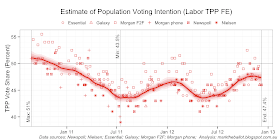Two polls in the last 24 hours: Both Newspoll and Essential have estimated that the two-party preferred (TPP) vote share at 54 to 46 in the Coalition's favour. I have placed these latest data points into my various aggregation models.
Under the LOESS aggregation (with a 180-day localised regression span) - the current estimate of the ALP TPP population voting intention is 47 per cent. The LOESS regression does not make adjustments for polling house effects. Furthermore, the LOESS approach can be overly influenced by end-points in the data-stream.
Using a Bayesian fixed house-effects model, over a six month span in recognition that house effects can move around over the medium term, the ALP TPP population voting intention is 47.1 per cent. While this model includes a house effect, that effect is distributed around a constant over the period. Furthermore, the model only applies a relative effect with the constraint that the total effect for all of the polling houses sums to zero. At past elections, this has not been the case.
In applying the time-varying house effects model, I use the part of the model that eliminates noise (but hopefully retains signal). This model placed the Labor TPP at 47.4 per cent. Like the previous model, it also assumes that house effects sum to zero (but over six months on average).
Note, the house effects in the next chart are measured in relative terms to the other polling houses over six months.
I translate the current state of the polls to the Coalition winning around 85 or 86 seats.







No comments:
Post a Comment